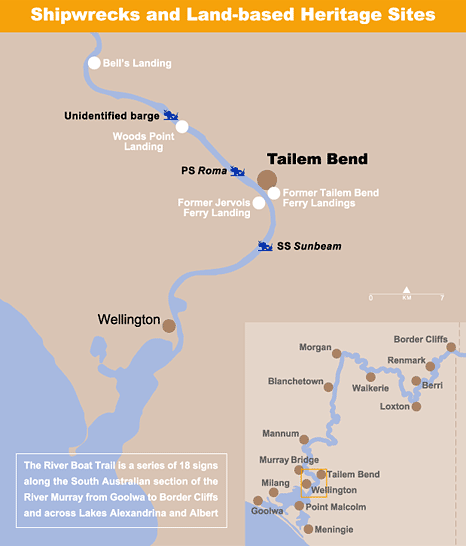
Tailem Bend and Jervois were primary dairy production areas
 Tailem Bend
Tailem Bend
In the early 1900s irrigation settlements were established along the lower Murray with one of the largest at Jervois. A dairy industry developed and for more than 20 years the milk was collected by a fleet of small river boats.
Milk Boats
From 1919 to the mid-1940s small launches were used to collect milk and cream from the dairy farms on the lower Murray and a new style of river boatman evolved, piloting these fast and powerful boats in all weathers.
The South Australian Farmers Union opened their Murray Bridge factory in 1922 and operated a fleet of milk launches including the Loyalty, the Union and the Co-operation and the Progress.
The Loyalty was one of the largest vessels, having a maximum load of 357 ten-gallon milk cans. The Union was purpose-built with a special opening at the side to enable the easy loading and discharge of the milk cans. All boats had a wooden canopy to protect the milk from the sun.
Each launch was operated b a driver an a boy, and stopped frequently at any wharf or landing where dairymen could leave their produce.
There were two runs daily, in each direction from Murray Bridge - upstream past Mannum and as far downstream as Wellington. The early morning trip was usually from 4am to 11am, with the afternoon collection from 1pm to 7pm.
The milk boats also delivered mail and groceries and often took farmers and their families into Murray Bridge. In some cases the launches transported children to and from school.
 The Tailem Bend Ferry Landing
The Tailem Bend Ferry Landing
As both the town of Tailem Bend and the settlement at Jervois developed, there was an increased need for a river crossing in the region.
The Tailem Bend Ferry Landing was constructed in 1924 and was one of the last government timber jetties built on the Murray.
The early landing was used until the mid-1960s, when the current crossing was constructed.
Today the remains of the 1927 Tailem Bend Ferry Landing are the most intact example of this type of timer landing, which at on time was common along the Murray River.
The structure is a significant State Heritage Place protected by the Heritage Places Act 1993.
Willows
The willows that dominate the Murray River landscape are not native; they were introduced to the region by the early settlers or planted during the river boat trade to assist navigation.
While some willows were planted to control erosion or for their beauty and summer shade, large numbers were planted from the 1860s to mark the river bank. During floods, many rive boat skippers gratefully followed the tops of the willows and knew that they were safely within the main channels.
Edward John Eyre planted one of the first willows at his property at Moorundie (near Blanchetown) in the early 1840s.
A picturesque weed
Because they were an introduced species, the deciduous willows have damaged the river's ecosystem and are now considered a pest.
The plants spread easily and broken branches or twigs can take root, quickly establishing new trees that clog the waterways and encourage sedimentation.
While willows are found along the whole length of the Murray, the stretch between Wellington and Mannum has the greatest concentration of this 'picturesque weed'.
GPS: Zone 54 E 0359463 N 6097263
Panel is overlooking the river at the turnoff from the Princes Highway to the Tailem Bend-Jervois Ferry
Interpretive panels are located at:
River Boat Trail | Border Cliffs | Renmark | Berri | Loxton | Waikerie | Morgan | Blanchetown | Mannum
Murray Bridge | Tailem Bend | Wellington | Meningie | Point Malcolm | Milang | Goolwa
Please do not interfere in any way with ship-wrecks and land based heritage sites
Published with permission of Government of South Australia
Department for Environment and Heritage
Tell your friends you found this at murrayriver.com.au!
Copyright Discover Murray 2026. This site or any portion of this site must not be reproduced, duplicated, copied, sold, resold, or otherwise exploited for any commercial purpose that is not expressly permitted by DISCOVER MURRAY.






 Amy Shark The Solo Acoustic "Songs & Stories" Tour
Amy Shark The Solo Acoustic "Songs & Stories" Tour The Australian Beach Boys Show
The Australian Beach Boys Show Kevin Bloody Wilson Aussie Icon Tour with special guest Jenny Talia
Kevin Bloody Wilson Aussie Icon Tour with special guest Jenny Talia Little By Little
Little By Little Lee Kernaghan Boys From The Bush The Concert
Lee Kernaghan Boys From The Bush The Concert